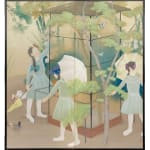Matsushima Hakkō, attr.
Saezuri (Twittering Birds), ca 1932
Two-panel folding screen; ink, mineral pigments, shell powder, and gold wash on silk
Size 66 x 61 inches (167.5 x 155.3 cm)
T-4490
Further images
-
(View a larger image of thumbnail 1
)

-
(View a larger image of thumbnail 2
)

-
(View a larger image of thumbnail 3
)

-
(View a larger image of thumbnail 4
)

-
(View a larger image of thumbnail 5
)

-
(View a larger image of thumbnail 6
)

-
(View a larger image of thumbnail 7
)

-
(View a larger image of thumbnail 8
)

-
(View a larger image of thumbnail 9
)

-
(View a larger image of thumbnail 10
)

-
(View a larger image of thumbnail 11
)

-
(View a larger image of thumbnail 12
)

-
(View a larger image of thumbnail 13
)

-
(View a larger image of thumbnail 14
)

-
(View a larger image of thumbnail 15
)

-
(View a larger image of thumbnail 16
)

-
(View a larger image of thumbnail 17
)

-
(View a larger image of thumbnail 18
)

Three schoolgirls, perhaps on a field trip, dressed in uniform frocks, white stockings, and white shoes, each holding an umbrella, one with a brimmed and beribboned hat and the other...
Three schoolgirls, perhaps on a field trip, dressed in uniform frocks, white stockings, and white shoes, each holding an umbrella, one with a brimmed and beribboned hat and the other two each with a bright dab of red lipstick, pause to examine a large cage containing small wild birds. A slender maple grows in the foreground and in the background are hollyhocks and a pine; pigeons roam free outside the cage.
The screen—a variation on the fashionable theme of bijinga, pictures of beautiful women—bears an illegible worn seal, but a very similar composition, less ambitious and showing a single girl, again with a birdcage as the other main subject, was exhibited by Matsushima Hakkō at the Thirteenth Teiten Exhibition in 1932. A native of Okayama Prefecture (birth name Matsushima Shōtarō), Matsushima Hakkō graduated in 1921 from the Painting Department of Tokyo Art School, where his teachers included Yuki Somei (1875–1957). He was first selected for the Bunten national exhibition in 1918, showing a painting of pensive half-Japanese lady sending a letter home from Jakarta during the Edo period (1615–1868). In the same year that Matsushima graduated, he immediately became an instructor at the Women’s School of Art. The following year, 1922, he received a merit award for a painting of a young lady shown at the Tōkyō Hakurankai (Tokyo Exposition). In 1936 he executed a mural for the Tōkyō Yōseikan, an important educational building, depicting the moment when the Tokugawa shogun agreed to transfer powers to the Meiji emperor. In 1937 Matsushima died, aged only 41 or 42. Most of Matsushima’s nine other submissions to the national exhibitions are similar in style and subject to the present work, all figural and typically depicting young women (sometimes Chinese) in elegant domestic settings, executed in the same beguilingly naïve manner. So few of his works are extant that it is hard to make technical comparisons, but the present screen is remarkable for the care and attention to detail that the artist lavished on this charming scene; especially noteworthy are the skillful rendition of the hollyhocks seen through two layers of the cage’s slender bars and the subtle deployment of gofun, powdered oyster shell, to model the girls’ elegant frocks.
The screen—a variation on the fashionable theme of bijinga, pictures of beautiful women—bears an illegible worn seal, but a very similar composition, less ambitious and showing a single girl, again with a birdcage as the other main subject, was exhibited by Matsushima Hakkō at the Thirteenth Teiten Exhibition in 1932. A native of Okayama Prefecture (birth name Matsushima Shōtarō), Matsushima Hakkō graduated in 1921 from the Painting Department of Tokyo Art School, where his teachers included Yuki Somei (1875–1957). He was first selected for the Bunten national exhibition in 1918, showing a painting of pensive half-Japanese lady sending a letter home from Jakarta during the Edo period (1615–1868). In the same year that Matsushima graduated, he immediately became an instructor at the Women’s School of Art. The following year, 1922, he received a merit award for a painting of a young lady shown at the Tōkyō Hakurankai (Tokyo Exposition). In 1936 he executed a mural for the Tōkyō Yōseikan, an important educational building, depicting the moment when the Tokugawa shogun agreed to transfer powers to the Meiji emperor. In 1937 Matsushima died, aged only 41 or 42. Most of Matsushima’s nine other submissions to the national exhibitions are similar in style and subject to the present work, all figural and typically depicting young women (sometimes Chinese) in elegant domestic settings, executed in the same beguilingly naïve manner. So few of his works are extant that it is hard to make technical comparisons, but the present screen is remarkable for the care and attention to detail that the artist lavished on this charming scene; especially noteworthy are the skillful rendition of the hollyhocks seen through two layers of the cage’s slender bars and the subtle deployment of gofun, powdered oyster shell, to model the girls’ elegant frocks.

















